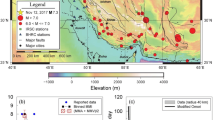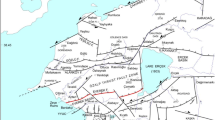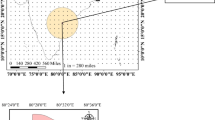Abstract
During 2006–2016, a strong motion seismic network of twenty 3-component accelerogarphs was deployed by the National Geophysical Research Institute, Hyderabad, India, in the epicentral region of the 2001 Mw7.7 Bhuj earthquake. On 7 March and 6 April 2006, two earthquakes of Mw5.5 have occurred in the Kachchh seismic zone, which led to an excellent dataset from 16 to 18 strong-motion accelerograph sites. This dataset enabled us to estimate strong motion parameters for these earthquakes that allowed us to examine the suitability of the design response spectra of BIS (criteria for earthquake-resistant design of structures, part I—general provisions and buildings, Bureau of Indian Standards, 2002) in Kachchh, Gujarat. Our study reveals that the estimated normalized response spectra at strong-motion accelerograph sites, which are lying in tertiary formations or near a zone of geological contact between Jurassic and tertiary formations, exceeded the design response spectra at 0.07–0.2 s, correlating with complete collapse of low-rise buildings, water tanks and dams in the area during the 2001 Bhuj earthquake. While the normalized acceleration spectrum of hard sediment (rock site) is found to not exceeding the design spectrum, correlating with the lack of damage in the Mesozoic hill zone. The estimated normalized acceleration spectra at SMA sites lying on hard sediments of Jurassic/Mesozoic formations are found to be lower than the design spectra, which suggests that these stations are less hazardous. We also notice that spectral acceleration values at few sites lying on quaternary formations have exceeded the design spectra at 3–4 s, suggesting these sites hazardous for engineered reinforced structures like bridges. Our estimated mean pseudo velocity spectra show peaks at 0.2, 0.5, 1.2 and 6 s. The peak at 6 s probably can cause damages to the reinforced engineered structures while the peak at 1.2 s could be causing damages to the multistoried reinforced buildings, as observed during the occurrence of the 2001 Bhuj mainshock. Thus, our estimated normalized acceleration spectra show peaks exceeding the design spectra at shorter (0.07–0.2 s, 0.5 s, 1–1.2 s) as well as longer periods (3–4 s, 6 s), which could be attributed to local site effects. We also notice that the modeled normalized response spectra for the shallow March event shows a better correlation with the NGA West2 model for tectonically active regions of US while the modeled normalized spectra for the deeper April event suggest a better correlation with the NGA east model for the stable parts of USA. We propose that the design spectra for the Kachchh region, Gujarat, India, should be modified incorporating local site, path and source effects.









Similar content being viewed by others
References
Abrahamson NA, Silva WJ, Kamai R (2014) Summary of the ASK14 ground motion relation for active crustal regions. Earthq Spectra 30:1025–1055
Agarwal P, Thakkar SK, Dubey RN (2002) Seismic performance of reinforced concrete buildings during Bhuj earthquake of January 26, 2001. ISET J Earthq Technol 39:195–217
Boore DM, Atkinson GM (2007) Boore-Atkinson NGA ground motion relations for the geometric mean horizontal component of peak and spectral ground motion parameters. Pacific earthquake engineering research center (PEER) report 2007/01 College of Engineering. University of California, Berkeley. pp 1–107
Boore DM, Stewart JP, Seyhan E, Atkinson GA (2014) NGA-West2 equations for predicting PGA, PGV, and 5% damped PSA for shallow crustal earthquakes. Earthq Spectra 30:1057–1085
Bureau of Indian Standards (BIS) (2002) Criteria for earthquake resistant design of structures, part I—general provisions and buildings. Bureau of Indian Standards 2002; IS 1893 [part I]
Campbell KW (2000) Erratum: empirical near-source attenuation relationships for horizontal and vertical components of peak ground acceleration, peak ground velocity, and pseudo absolute acceleration response spectra. Seism Res Lett 71:352–354
Campbell KW, Bozorgnia GM (2007) Campbell-Bozorgnia NGA Ground motion relations for the geometric mean horizontal component of peak and spectral ground motion parameters. Pacific earthquake engineering research center (PEER) report 2007/01 College of Engineering. University of California, Berkeley. pp 1–107
Campbell KW, Bozorgnia Y (2014) NGA-West2 ground motion model for the average horizontal components of PGA, PGV, and 5% damped linear acceleration response spectra. Earthq Spectra 30:1087–1115
Chiou BS-J, Youngs RR (2014) Update of the Chiou and Youngs NGA model for the average horizontal component of peak ground motion and response spectra. Earthq Spectra 30:1117–1153
Chopra S, Choudhury P (2011) A study of response spectra for different geological conditions in Gujarat, India. Soil Dyn Earthq Eng 31:1551–1564
Chopra S, Rao KM, Rastogi BK (2010) Estimation of sedimentary thickness in Kachchhbasin, Gujarat Using Sp converted Phase. Pure Appl Geophys 167:1247–1257
Cramer CH, Kumar A (2003) 2001 Bhuj, India earthquake engineering seismoscope recordings and eastern north America ground-motion attenuation relations. Bull Seismol Soc Am 93:390–394
Douglas J (2003) Earthquake ground motion estimation using strong-motion records: a review of equations for the estimation of peak ground acceleration and response spectral ordinates. Earth-Sci Rev 61:43–104
Durukal E, Erdik M, Avci O, Yuzugullu Y, Alpay Y, Avar B, Zulfikar C, Biro T, Mert A (1998) Analysis of the strong motion data of the 1995 Dinar, Turkey earthquake. Soil Dyn Earthq Eng 17:557–578
Gaur VK (1994) Estimating strong ground motion parameters for earthquake-resistant design. Curr Sci 67:311–312
Hisada Y, Meguro K (2001) Estimation of macroseismic intensity. In: A comprehensive survey of the 26 January 2001 earthquake (Mw7.7) in the State of Gujarat, India. Research Report on Natural Disasters, Japan Ministry of Education, December 2001, pp 56–63
Inukai M (2008) Acceleration records in recent earthquakes and structural response values. In: The 14th world conference on earthquake engineering, October 12–17, 2008, Beijing, China
Iyengar RN, Raghukanth STG (2006) Strong ground motion estimation during the Kutch, India Earthquake. Pure Appl Geophys 163:153–173
Kawase H (1996) Site Effects observed during the Hyogo-Ken Nanbu earthquake of 1995 and strong motion simulation including the basin edge effect, In: Eleventh world conference on earthquake engineering, 1996, Paper no. 2031, Tokyo, Japan
Mandal P (2007) Sediment thicknesses and Qs vs. Qp relations in the Kachchh rift basin, Gujarat, India using Sp converted phases. Pure Appl Geophys 164:135–160
Mandal P, Satyamurthy C, Raju IP (2009a) Iterative de-convolution of the local waveforms: characterization of the seismic sources in Kachchh, India. Tectonophysics 478:143–157
Mandal P, Kumar N, Satyamurthy C, Raju IP (2009b) Ground motion attenuation relation from strong-motion records of the 2001 Mw 7.7 Bhuj Earthquake Sequence (2001–2006), Gujarat. India Pure Appl Geophys 166:451–469
Mandal P, Dutta U, Chadha RK (2008) Estimation of site response in the Kachchh seismic zone, Gujarat, India. Bull Seismol Soc Am 98:2559–2566
Mandal P, Dutta U (2011) Estimation of earthquake source parameters and site response. Bull Seismol Soc Am 101:1719–1731
Motosaka M, Nagano M (1996) Analysis of ground-motion amplification characteristics in kobe city considering a deep irregular underground structure interpretation of heavily damaged belt zone during the 1995. Hyogo-ken Nanbu Earthq J Phys Earth 44:577–590
Raghukanth STG, Iyengar RN (2007) Estimation of seismic spectral acceleration in Peninsular India. J Earth Syst Sci 116:199–214
Rajendran CP, Rajendran K (2001) Character of deformation and past seismicity associatedwith 1819 the Kachchh earthquake, north-western India. Bull Seismol Soc Am 91:407–426
Rajendran CP, Rajendran K, Thakkar M, Goyal B (2008) Assessing the previous activityat the source zone of the 2001 Bhuj earthquake based on the near-source and distant paleoseismological indicators. J Geophys Res 113:1–17
Singh SK, Bansal BK, Bhattacharya SN, Pacheco J, Dattatrayam R, Ordaz M, Suresh G, Kamal HSE (2003) Estimation ofground motion from Bhuj (26 January, 2001; Mw7.6) and from future earthquakes in India. Bull Seismol Soc Am 93:353–370
Singh AP, Shukla A, Kumar MR, Thakkar MG (2017) Characterizing surface Geology, Liquefaction potential, and maximum intensity in the Kachchh Seismic zone, western India, through microtremor analysis. Bull Seismol Soc Am. https://doi.org/10.1785/0120160264
Somerville P, Collins N, Abrahamson N, Graves R, Saikia C (2001) Ground motion attenuation relations for the central and eastern United States. USGS report Award No.: 99HQGR0098, pp 1–33
Su F, Anderson J G, Zeng Y (2006) Characteristics of ground motion response spectrafrom recent large earthquakes and their comparison with IEEE standard 693. In: Proceedings of 100th anniversary earthquake conference, commemorating the 1906 San Francisco Earthquake. San Francisco, California; April 18–22, 2006
Toro G, Abrahamson N, Schneider J (1997) Model of strong ground motions from earthquakes incentral and eastern North America: best estimates and uncertainties. Seismol Res Lett 68:41–67
Trifunac MD (1973) Analysis of strong earthquake ground motion for prediction of response spectra. Earthq Eng Struct Dyn 2:59–69
Wu YM, Teng TL, Shin TC, Hsiao NC (2003) Relationship between peak ground acceleration, peak ground velocity, and intensity in Taiwan. Bull Seismol Soc Am 93:386–396
Acknowledgements
The author is grateful to the Director of the National Geophysical Research Institute, Hyderabad, India, for his support and permission to publish this work. The Ministry of Earth Sciences (MoES) (Grant No. GAP-740-28(PM)), New Delhi, supported this study. The work reported in this paper has also been supported by the Council of Scientific and Industrial Research twelfth five-year plan project (HEART) at the Council of Scientific and Industrial Research National Geophysical Research Institute (CSIR-NGRI), Hyderabad. Thus, strong-motion accelerograms of local earthquakes used in this study can be obtained by sending a request to the Director, NGRI, Hyderabad (director@ngri.res.in). We used Seismic Analysis Code (SAC2000) for performing routine data analysis of strong-motion earthquake data, which can be accessed through https://www.iris.edu/manuals/sac/SAC_Home_Main.html, last accessed on 7 March 2019).
Author information
Authors and Affiliations
Corresponding author
Additional information
Publisher's Note
Springer Nature remains neutral with regard to jurisdictional claims in published maps and institutional affiliations.
Rights and permissions
About this article
Cite this article
Mandal, P. Strong ground motions from two moderate size (Mw5.5) Kachchh intraplate earthquakes, Gujarat, India. Nat Hazards 103, 2441–2458 (2020). https://doi.org/10.1007/s11069-020-04092-8
Received:
Accepted:
Published:
Issue Date:
DOI: https://doi.org/10.1007/s11069-020-04092-8




